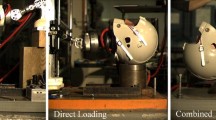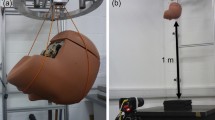Abstract
This paper reports the development of a test device for replicating unique features of concussion-causing helmet-to-ground impacts. Helmet-to-ground impacts are characterized by an oblique impact velocity vector, preimpact rotational motion of the helmeted head, and an impact into a compliant frictional surface of unknown effective mass. No helmet assessment testing program replicates these impact characteristics, yet they influence brain injury risk and therefore may influence helmet design priorities. To replicate these mechanics, the carriage of a drop tower was modified by the addition of a curvilinear bearing track and a hinged torso-neck fixture to which a helmeted head of a Hybrid III anthropomorphic test device was mounted. Preimpact rotational motion of the head was imparted by forcing a link arm to follow the curvilinear path as the carriage fell under gravity. At impact, the rotating helmeted head struck a vertically mounted surface. The ground impact features of head kinematics are illustrated by comparing rear impacts into a rigid, low-friction surface against those into a compliant frictional surface simulating turf. With the rigid, low-friction surface, the head experienced a change in rotational rate of approximately 40 rad/s, which corresponded to a peak rotational acceleration of approximately αy = − 4000 rad/s2. In contrast, peak rotational acceleration with the compliant frictional surface was approximately αy = − 1000 rad/s2 while the helmet was in contact with the surface. Neck loads were significantly greater with the compliant frictional surface. Translational head acceleration was less sensitive to the surface characteristics, with the peak of the anterior-posterior component essentially unchanged.







Similar content being viewed by others
References
Bailey, A., J. Funk, D. Lessley, C. Sherwood, J. Crandall, W. Neale, and N. Rose. Validation of a videogrammetry technique for analyzing football helmet kinematics. Sports Biomech. 2018. https://doi.org/10.1080/14763141.2018.1513059.
Bass, C., L. Donnellan, R. Salzar, S. Lucas, B. Folk, M. Davis, K. Rafaels, C. Planchak, K. Meyerhoff, A. Ziemba, and N. Alem. A new neck injury criterion in combined vertical/frontal crashes with head supported mass. Conf. Proc. Int. Res. Counc. Biomech. Inj. 75–91:2006, 2006.
Biocore. Helmet Test Protocol, March 2020. https://www.biocorellc.com/publications/. Accessed April 20, 2020.
Bertocci, G., M. Pierce, E. Deemer, F. Aguel, J. Janosky, and E. Vogeley. Using test dummy experiments to investigate pediatric injury risk in simulated short-distance falls. Arch. Pediatr. Adolesc. Med. 157(5):480–486, 2003.
Beusenberg, M., N. Shewchenko, J. Newman, R. DeLange, and H. Cappon. Head, neck, and body coupling in reconstructions of helmeted head impacts. Conf. Proc. Int. Res. Counc. Biomech. Inj. 1–17:2001, 2001.
Bland, M., D. Zuby, B. Mueller, and S. Rowson. Differences in the protective capabilities of bicycle helmets in real-world and standard-specified impact scenarios. Traffic. Inj. Prev. 19(S1):S158–S163, 2018.
Bland, M., C. McNally, D. Zuby, B. Mueller, and S. Rowson. Development of the STAR evaluation system for assessing bicycle helmet protective performance. Ann. Biomed. Eng. 48:47–57, 2020.
Clark, J., K. Taylor, A. Post, T. Hoshizaki, and M. Gilchrist. Comparison of ice hockey goaltender helmets for concussion type impacts. Ann. Biomed. Eng. 46:986–1000, 2018.
Funk, J., J. Crandall, M. Wonnacott, and C. Withnall. NFL Linear Impactor Helmet Test Protocol. 2019. https://www.biocorellc.com/publications/. Accessed April 20, 2020.
Gabler, L., J. Crandall, and M. Panzer. Assessment of kinematic brain injury metrics for predicting strain responses in diverse automotive impact conditions. Ann. Biomed. Eng. 44(12):3705–3718, 2016.
Jadischke, R., D. C. Viano, J. McCarthy, and A. I. King. The effects of helmet weight on hybrid III head and neck responses by comparing un-helmeted and helmented impacts. J. Biomech. Eng. 138(10):1–10, 2016.
Kang, Y., K. Moorhouse, and J. Bolte. Measurement of six degrees of freedom head kinematics in impact conditions employing six accelerometers and three angular rate sensors (6aω configuration). J Biomech Eng. 2011. https://doi.org/10.1115/1.4005427.
Kent, R., J. Forman, A. Bailey, J. Funk, C. Sherwood, J. Crandall, K. Arbogast, and B. Myers. The biomechanics of concussive helmet-to-ground impacts in the National Football League. J. Biomech. 99(109551):1–7, 2020.
Kerrigan, J., C. Arregui, and J. Crandall. Pedestrian head impact dynamics: comparison of dummy and PMHS in small and large SUV impacts. In: Proc Enhanced Safety of Vehicles, Paper 09-0127, 2009.
Lessley, D., R. Kent, J. Funk, C. Sherwood, J. Cormier, J. Crandall, K. Arbogast, and B. Myers. Video analysis of reported concussion events in the National Football League during the 2015-2016 and 2016-2017 seasons. Am. J. Sports Med. 46(14):3502–3510, 2018.
Meng, S., A. Cernicchi, S. Kleiven, and P. Halldin. The biomechanical differences of shock absorption test methods in the US and European helmet standards. I. J. Crash 24(4):399–412, 2019.
Naunheim, R., H. Parrott, and J. Standeven. A comparison of artificial turf. J. Trauma Acute Care Surg. 57:1311–1314, 2004.
NOCSAE. Standard Method of Impact Test and Performance Requirements for Football Faceguards (No. NOCSAE DOC 087-12m15a). National Operating Committee on Standards for Athletic Equipment, 2015.
Parent, D., M. Craig, and K. Moorhouse. Biofidelity evaluation of the THOR and Hybrid III 50th percentile male frontal impact anthropomorphic test devices. Stapp Car Crash J. 61:227–276, 2017.
Pellman, E., J. Powell, D. Viano, I. Casson, A. Tucker, H. Feuer, M. Lovell, J. Waeckerle, and D. Robertson. Concussion in professional football: epidemiological features of game injuries and review of the literature—part 3. Neurosurgery 54(1):81–96, 2004.
Pellman, E., D. Viano, C. Withnall, N. Shewchenko, and C. Bir. Concussion in professional football: helmet testing to assess impact performance—part 11. Neurosurgery 58(1):78–95, 2006.
Rowson, S., and S. M. Duma. Development of the star evaluation system for football helmets: Integrating player head impact exposure and risk of concussion. Ann Biomed Eng. 39:2130–2140, 2011.
Shorten, M., and J. Himmelsbach. Sports surfaces and the risk of traumatic brain injury. In: Sports Surfaces, edited by B. M. Nigg, G. K. Cole, and D. J. Stefanyshyn. Calgary: University of Calgary, 2003, pp. 49–69.
Smith, T., D. Halstead, E. McCalley, S. Kebschull, S. Halstead, and J. Killeffer. Angular head motion with and without head contact: implications for brain injury. Sports Eng. 18(3):165–175, 2015.
Takhounts, E., M. Craig, K. Moorhouse, J. McFadden, and V. Hasija. Development of brain injury criteria (Br IC). Stapp Car Crash J. 57:243–266, 2013.
Theobald, P., L. Whitelegg, L. Nokes, and M. Jones. The predicted risk of head injury from fall-related impacts on to third-generation artificial turf and grass soccer surfaces: a comparative biomechanical analysis. Sports Biomech. 9(1):29–37, 2010.
Viano, D., C. Withnall, and M. Wonnacott. Football helmet drop tests on different fields using an instrumented Hybrid III head. Ann. Biomed. Eng. 40(1):97–105, 2012.
Viano, D. C., C. Withnall, and D. Halstead. Impact performance of modern football helmets. Ann. Biomed. Eng. 40:160–174, 2012.
Willinger, R., C. Deck, P. Halldin, and D. Otte. Towards advanced bicycle helmet test methods. Conf. Proc. Int. Cycl. Saf. Conf. 2014:1–11, 2014.
Withnall, C. Personal communication of material presented on November 10, 2014 to ASTM F08.65.13 Task Group, 2020.
Acknowledgements
The research presented in this paper was made possible by a Grant from Football Research, Inc. (FRI). FRI is a nonprofit corporation that receives funding from sources including the NFL and is dedicated to the research and development of novel methods to prevent, mitigate, and treat traumatic head injury. The views expressed are solely those of the authors and do not represent those of FRI or any of its affiliates or funding sources. The authors gratefully acknowledge the testing assistance of Peter Young and Brian McEwen.
Author information
Authors and Affiliations
Corresponding author
Additional information
Associate Editor Dan Elson oversaw the review of this article.
Publisher's Note
Springer Nature remains neutral with regard to jurisdictional claims in published maps and institutional affiliations.
Electronic supplementary material
Below is the link to the electronic supplementary material.
Rights and permissions
About this article
Cite this article
Kent, R., Forman, J., Bailey, A. et al. Surface Contact Features, Impact Obliquity, and Preimpact Rotational Motion in Concussive Helmet-to-Ground Impacts: Assessment via a New Impact Test Device. Ann Biomed Eng 48, 2639–2651 (2020). https://doi.org/10.1007/s10439-020-02621-x
Received:
Accepted:
Published:
Issue Date:
DOI: https://doi.org/10.1007/s10439-020-02621-x




